Contents
Back to top
Global Warming and Hurricanes
An Overview of Current Research Results
This site authored and maintained by: Tom Knutson, Senior Scientist, NOAA/GFDL
Any views expressed here are the author’s and do not represent official views of NOAA or the U.S. government. A State of the Science Fact Sheet, reviewed and vetted by NOAA, is found here.
Last Revised: Nov. 20, 2024
Recent Assessments of Tropical Cyclones and Climate Change:
- NOAA State of Science Fact Sheet on “Atlantic Hurricanes and Climate Change” (May 2023).
- Intergovernmental Panel on Climate Change Sixth Assessment Report, Working Group I, (2021)
- ScienceBrief Review on Tropical Cyclones and Climate Change, (2021).
- WMO Task Team assessment on tropical cyclones and climate change, published (2019; 2020) in the Bulletin of the American Meteorological Society:
1. Summary Statement
Two frequently asked questions on global warming and hurricanes are the following:
- What changes in hurricane activity are expected for the late 21st century, given the pronounced global warming scenarios from IPCC models?
- Have humans already caused a detectable increase in Atlantic hurricane activity or global tropical cyclone activity?
The IPCC AR6 presents a strong body of scientific evidence that it is unequivocal that humans have caused the earth’s climate to warm, with a likely human contribution of 0.8 to 1.3 degrees Celsius to global mean temperature since the late 1800s. But what does this anthropogenic global warming mean for Atlantic hurricane activity, or global tropical cyclone activity? Here, we address these questions, starting with those conclusions where we have relatively more confidence. The main text of this web page gives more background discussion. “Detectable” change here will refer to a change that is large enough to be clearly distinguishable from the variability due to natural causes. Our main conclusions are:
- Sea level rise – which human activity has very likely been the main driver of since at least 1971 according to IPCC AR6 – should be causing higher coastal inundation levels for tropical cyclones that do occur, all else assumed equal.
- Tropical cyclone rainfall rates are projected to increase in the future (medium to high confidence) due to anthropogenic warming and accompanying increase in atmospheric moisture content. Modeling studies on average project an increase by about 14% (+6 to +22%) globally for rainfall rates averaged within about 100 km of the storm for a 2 degree Celsius global warming scenario.
- Tropical cyclone intensities globally are projected to increase (medium to high confidence) on average (by 1 to 10% according to model projections for a 2 degree Celsius global warming). This change would imply an even larger percentage increase in the destructive potential per storm, assuming no reduction in storm size. Rapid intensification is also projected to increase. Storm size responses to anthropogenic warming are uncertain.
- The global proportion of tropical cyclones that reach very intense (Category 4 and 5) levels is projected to increase (medium to high confidence) due to anthropogenic warming over the 21st century. There is less confidence in future projections of the global number of Category 4 and 5 storms, since most modeling studies project a decrease (or little change) in the global frequency of all tropical cyclones combined.
For the above tropical cyclone projections, the IPCC AR6 generally concluded there was high confidence as compared to medium-to-high confidence in the WMO assessment. Additional research was published between the reports, which can affect confidence levels. Also, confidence levels for assessment statements can vary between authors within a given report.
- In terms of detection and attribution, much less is known about human contributions to hurricane/tropical cyclone activity changes to date, compared to the case for global mean temperature. Recent findings include:
- In the northwest Pacific basin, observations show a poleward shift in the latitude of maximum intensity of tropical cyclones. This change is assessed to be detectable (i.e., not explainable by natural variability alone) with medium confidence by IPCC AR6) or low-to-medium confidence (WMO Task Team report).
- One study finds an increase in the fraction of tropical cyclone intensity “fixes” (6-hourly observations) that are at least Category 3 intensity both globally and in the Atlantic basin, over the period 1979-2017. These observed changes have not been confidently attributed to anthropogenic forcing. The global increase was assessed to be detectable (i.e., not explainable by natural variability alone) with medium confidence by IPCC AR6. The increase in proportion of Category 3-5 intensity “fixes” was reported to be mostly due to a global decrease in the number of Category 1-5 intensity “fixes”, together with a slight (non-significant) global increase in the number of Category 3-5 intensity “fixes”.
- Analyses of rapid intensification of tropical cyclones indicate an observed increase in the probability of rapid intensification (1982-2017) in the Atlantic, NW Pacifc, and globally, which is highly unusual compared to one climate model’s simulation of internal multidecadal climate variability, and thus is a possibly emerging detectable anthropogenic change. This change is assessed to be detectable (i.e., not explainable by natural variability alone) with medium confidence by IPCC AR6. The increase is consistent in sign with the model’s simulated long-term response to anthropogenic forcing.
- There is increasing evidence from modeling studies at GFDL/NOAA and the UK Met Office/Hadley Centre (UKMO) that the increase in tropical storm frequency in the Atlantic basin since the 1970s has been at least partly driven by decreases in aerosols from human activity and volcanic forcing. Natural variability or changes in Saharan dust emissions may also have contributed to recent changes. The recent GFDL and UKMO studies do not imply that the increase in Atlantic tropical storm frequency since the 1970s will continue into the future: these same models project future decreases in Atlantic tropical storm frequency in response to increasing greenhouse gas concentrations.
- There is evidence for a slowing of tropical cyclone propagation speeds over the continental U.S. over the past century–which could lead to higher precipitation accumulations in a given location–but these observed changes have not yet been confidently linked to anthropogenic climate change. This change is assessed to be detectable (i.e., not explainable by natural variability alone) with medium confidence by IPCC AR6.
- There is no strong evidence of century-scale increasing trends in U.S. landfalling hurricanes or major hurricanes. Similarly for Atlantic basin-wide hurricane frequency (after adjusting for changing observing capabilities over time), there is not strong evidence for an increase since the late 1800s in hurricanes, major hurricanes, or the proportion of hurricanes that reach major hurricane intensity.
- According to the IPCC AR6 Summary for Policymakers, there is high confidence that anthropogenic climate change has increased extreme tropical cyclone rainfall, based on available event attribution studies and physical understanding. However, they note that clear detection of past trends at the global scale in this metric is inhibited due to data limitations. IPCC AR6, in Chapter 11 of the above report, concludes that there is medium confidence, based on event attribution studies, that anthropogenic climate change has contributed to extreme rainfall in strong tropical cyclones.
- In summary, it is premature to conclude with high confidence that human-caused increases in greenhouse gases have caused a change in past Atlantic basin hurricane activity that is outside the range of natural variability, although greenhouse gases are strongly linked to global warming. Some possible emerging human influences on past tropical cyclone activity were summarized above. These include, for the Atlantic, recent increases in rapid intensification probability, aerosol-driven changes in hurricane activity, increases in extreme tropical cyclone precipitation in some regions, and a slowing of storm propagation speeds over the U.S. A number of measures of Atlantic hurricane activity have increased since 1980, but in the of case of metrics where much longer records are available, trends since 1980 are not representative of longer (e.g., century-scale) trends. Substantial multidecadal variability in the Atlantic basin confounds efforts to detect long-term greenhouse gas-induced trends. At the global scale, increased intensities, rapid intensification (especially in near-coastal regions), and fraction of tropical cyclone 6-hourly “fixes” at high intensity are examples of possible emerging human influences, along with a poleward shift of the latitude of maximum tropical cyclone intensity in the Northwest Pacific basin. Human activities may have already caused other changes in tropical cyclone activity, in the Atlantic or globally, that are not yet clearly apparent due to the small magnitude of these changes compared to natural variability, or due to observational limitations.
2. Global Warming and Atlantic Hurricanes
A. Statistical relationships between SSTs and hurricanes
It is well known that hurricanes form over relatively warm sea surfaces, which has led to notions that global warming will greatly increase hurricane activity globally. This has led to the use of statistical analyses and models to study the relationships between Atlantic hurricanes and Atlantic sea surface temperatures. Emanuel (2007) found a strong correlation, on multi-year time-scales, between local tropical Atlantic sea surface temperatures (SSTs) and the Power Dissipation Index (PDI) for data through 2005— see an updated series — Fig. 3 of the EPA Climate Indicators site. PDI is an aggregate measure of Atlantic hurricane activity, combining frequency, intensity, and duration of hurricanes. Both Atlantic SSTs and PDI have risen sharply since the 1970s, and there is some evidence that PDI levels in recent years are higher than in the previous active Atlantic hurricane era in the 1950s and 60s.
Climate change detection/attribution studies have linked increasing tropical Atlantic SSTs to increasing greenhouse gases, but such a link between increasing hurricane PDI or frequency and increasing greenhouse gases has not been established. Nonetheless, the statistical linkage of Atlantic hurricane PDI to Atlantic SST suggests at least the possibility of a large anthropogenic influence on Atlantic hurricanes. If this statistical relation between tropical Atlantic SSTs and hurricane activity is used to infer future changes in Atlantic hurricane activity, the implications are sobering: the large increases in tropical Atlantic SSTs projected for the late 21st century would imply very substantial increases in hurricane destructive potential–roughly a 300% increase in the PDI by 2100 (Figure 1 from Vecchi et al. (2008), orange curve).
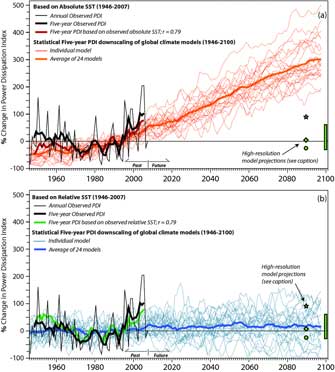
On the other hand, Swanson (2008) and others noted that Atlantic hurricane power dissipation is also well-correlated with other SST indices besides tropical Atlantic SST alone, and in particular with indices of Atlantic SST relative to tropical mean SST (e.g., Figure 1, blue curves). This is crucial distinction: the statistical relationship between Atlantic hurricanes and local Atlantic SST shown in the upper panel of Figure 1 would imply very large increases in Atlantic hurricane activity (PDI) due to 21st century greenhouse warming. However, the alternative statistical relationship between the PDI and the relative SST measure shown in the lower panel of Figure 1 would imply only modest future long-term trends of Atlantic hurricane activity (PDI). In the latter case, the relative SST measure (lower panel) does not change very much over the 21st century, even with substantial Atlantic warming projections from climate models, because, crucially, the warming projected for the tropical Atlantic in the models is not very different from that projected for the tropics as a whole.
The key questions then are: Which of the two future Atlantic hurricane scenarios inferred from the statistical relations in Figure 1 is more likely? Is absolute SST or relative SST the more appropriate predictor for greenhouse warming-induced change in Atlantic hurricanes? To try to gain insight on these questions, we will trace a series of studies that examine century-scale historical changes of Atlantic tropical storm and hurricane counts (Section 2B), and then we examine additional hurricane metrics, including several intensity-related metrics since the 1980s (Section 2C). In Section 2D we review dynamical modeling studies of Atlantic hurricane activity under greenhouse warming conditions, and in Section 2E some other possible influences on Atlantic hurricanes (besides greenhouse warming). In Section 3, we go beyond the Atlantic to consider global tropical cyclone activity and global warming.
B. Analysis of century-scale Atlantic tropical storm and hurricane frequency
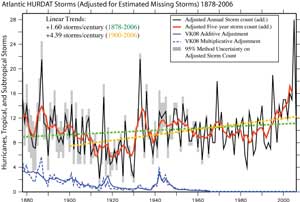
To gain more insight on the issue of Atlantic hurricanes and global warming, we have attempted to analyze much longer (> 100 yr) records of Atlantic tropical storm or hurricane activity. If greenhouse warming causes a substantial increase in Atlantic hurricane activity, then the observed century scale increase in tropical Atlantic SSTs since the late 1800s should have produced a long-term rise in measures of Atlantic hurricanes activity, similar to that seen for global temperature, for example.
Existing records of past Atlantic tropical storms (1878 to present) in fact do show a pronounced upward trend, which is also correlated with rising SSTs. However, the density of reporting ship traffic over the Atlantic was relatively sparse during the early decades of this record, such that if storms from the modern era (post 1965) had hypothetically occurred during those earlier decades, a substantial number of storms would likely not have been directly observed by the ship-based “observing network of opportunity.” We find that, after adjusting for such an estimated number of missing storms, there remains just a small nominally positive trend (not statistically significant) in tropical storm occurrence from 1878-2006 (Figure 2, from Vecchi and Knutson 2008). Landsea et al. (2010) expanded on this work, noting that the rising trend in (unadjusted) Atlantic tropical storm counts is almost entirely due to increases in short-duration (<2 day) storms alone. Such short-lived storms were particularly likely to have been overlooked in the earlier parts of the record, as they would have had less opportunity for chance encounters with ship traffic.
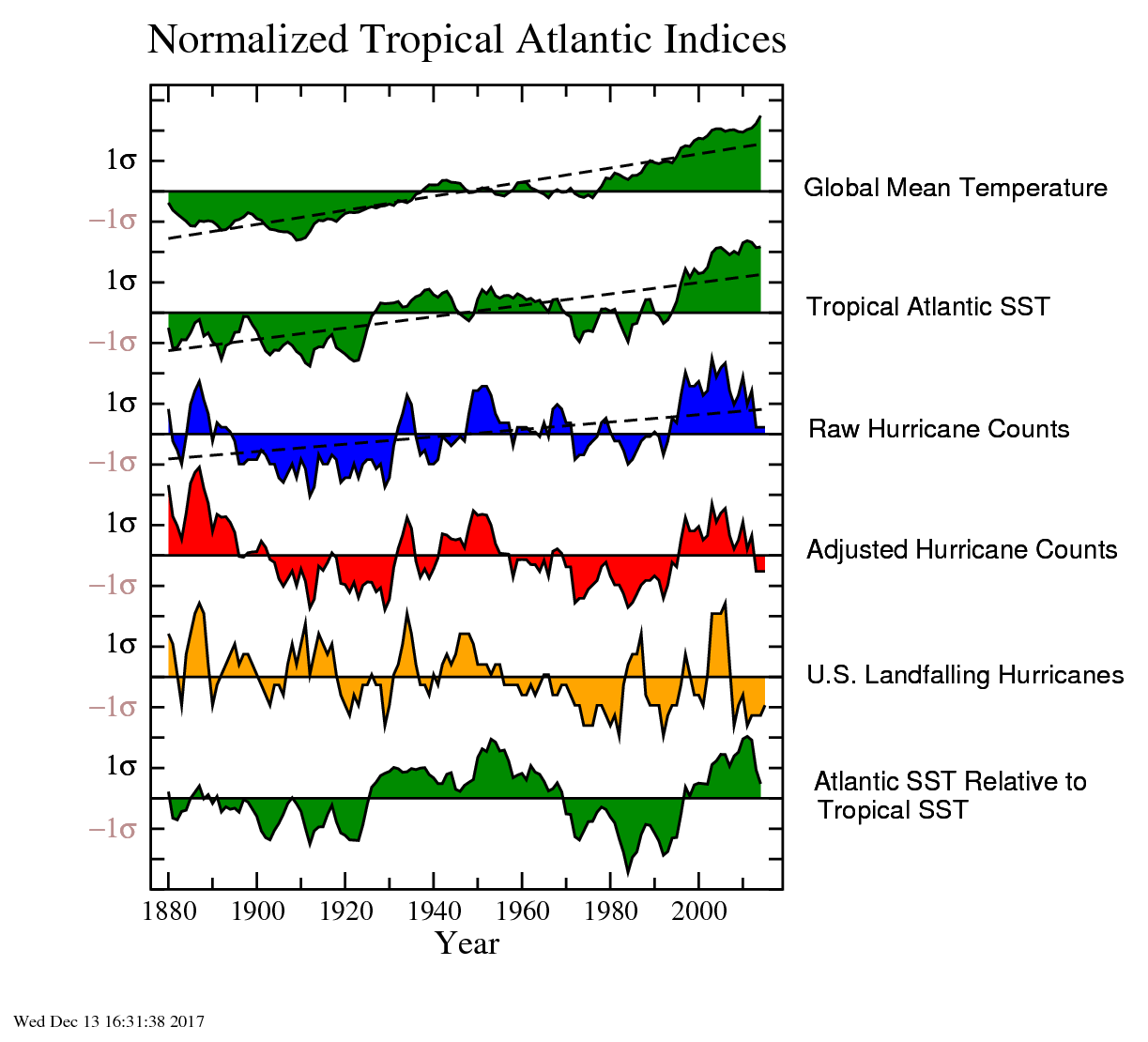
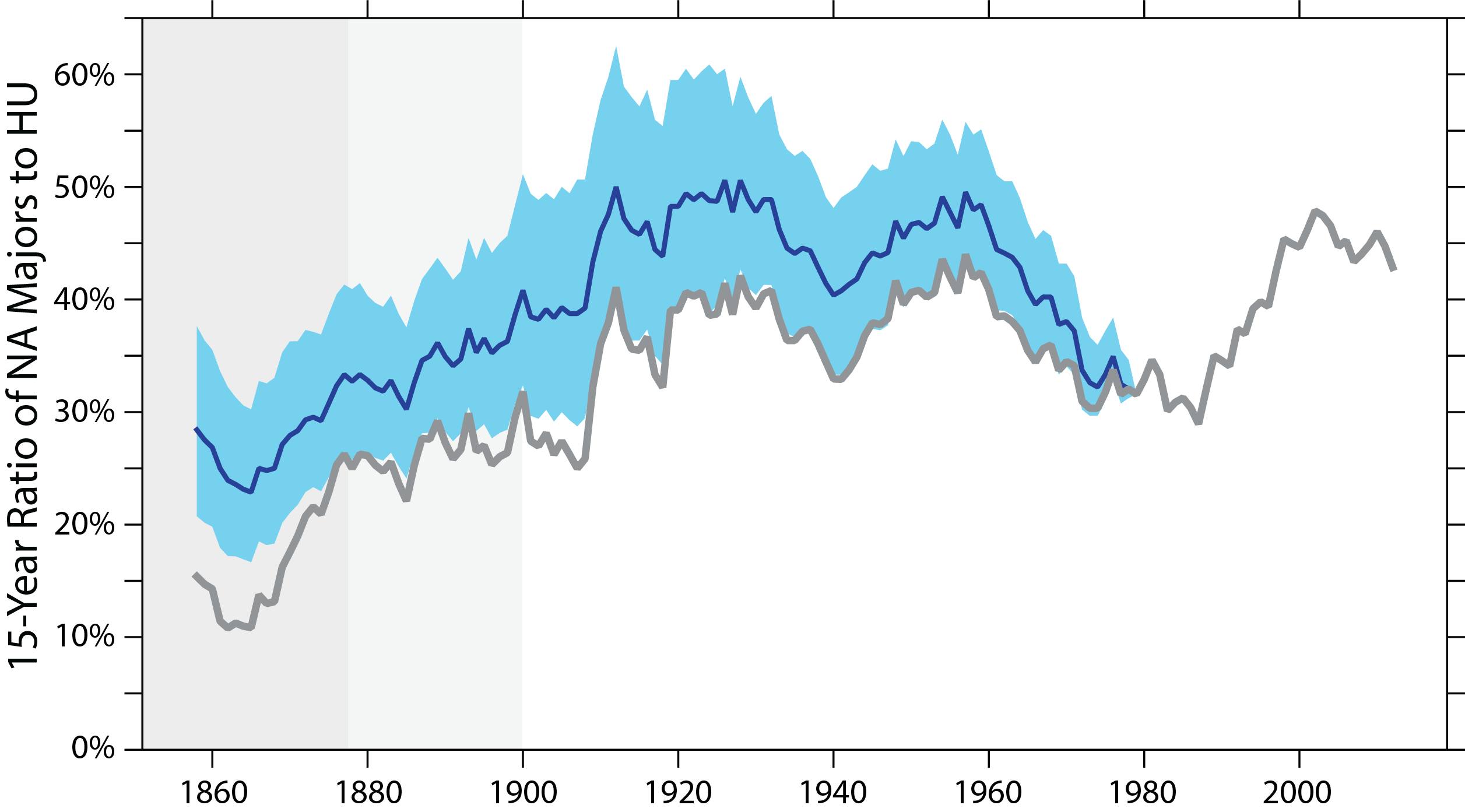
This same general methodology has since been applied to Atlantic basin hurricanes (Vecchi and Knutson 2011) and major hurricanes (Vecchi et al. 2021). Atlantic basin hurricanes (Fig. 3, blue curve), show a weak rising trend since the late 1800s, but assuming there are no missing hurricanes in earlier years. After adjusting for a likely under-count of hurricanes in the pre-satellite era (Fig. 3, red curve) there is essentially no long-term trend in hurricane counts.
The evidence for an upward trend is even weaker if we look at U.S. landfalling hurricanes, which even show a slight negative trend beginning from 1900 or from the late 1800s (Figure 3, orange curve). U.S. landfalling hurricane frequency is much less common than basin-wide frequency, meaning that the U.S. landfalling hurricane record, while more reliable than the basin-wide record, suffers from degraded signal-to-noise characteristics for assessing trends. The U.S. landfalling hurricane series (which has no “missing” storm adjustments) is similar to the adjusted basin-wide Atlantic hurricane counts in terms of its lack of century-scale trend (Fig. 3). Emanuel (2021) found that U.S. landfalling tropical cyclone frequency and power dissipation–for storms whose lifetime maximum winds exceeded 21 m/sec–had a period of unusually high activity from around 2004 to 2010 compared to the record extending into the late 1800s. It is not known if this represents an early sign of a climate change signal toward greater future U.S landfalling tropical cyclone activity or not.
Concerning Atlantic basin-wide major (Category 3-5) hurricanes, Vecchi et al. (2021) conclude that their counts also show little evidence of a long-term increase (since the 1880s) after accounting for changes in observing system capabilities; they also show that U.S. landfalling major hurricanes (with no adjustment) have no significant increasing trend since the late 1800s.
Figure 4 (from Vecchi et al. 2021) suggests that after adjusting for changes in observing capabilities (limited ship observations) in the pre-satellite era, there is no significant long-term trend (since the 1880s) in the proportion of hurricanes that become major hurricanes. The proportion of major hurricanes has increased in the Atlantic in recent decades (since 1980). This illustrates the challenge of finding significant long-term trends in hurricane intensity-related metrics if one extends the record back prior to the 1980s (e.g., to the late 1800s or early 1900s).
As far as Category 4-5 intensity storms, basin-wide unadjusted storm counts show a pronounced increase since the mid-1940s (Bender et al., 2010), but those authors cautioned that the data from such earlier decades needs to be carefully assessed for data inhomogeneity problems before such trends can be accepted as reliable.
Three recent studies used an alternative approach to estimate Atlantic or global tropical storm or hurricane counts over the past century or more: dynamical or statistical-dynamical models, forced by either observed sea surface temperatures or century-scale historical reanalyses of atmospheric conditions (Emanuel 2021; Chan et al. 2021; Chand et al. 2022). The studies came to differing conclusions about past Atlantic tropical storm or hurricane counts. For example, Emanuel’s study simulates a long-term increase of TCs over the Atlantic, but not in other basins, while Chand et al. (2022) simulates a substantial century-scale decreasing trend in Atlantic TCs. These two studies used century-scale atmospheric reanalyses in their tropical storm reconstructions, which introduces some uncertainties, since such reanalyses have been found to have questionable trend behavior in some fields such as sea level pressure (Knutson and Ploshay 2021). Meanwhile Chan et al. (2021) used only a new reconstruction of global sea surface temperatures in their Atlantic hurricane historical simulation. They found a similar trend behavior (little century scale trend) and multidecadal variability to the hurricane reconstructions of Vecchi and Knutson (2011) which, as discussed above, were based on raw observed storm counts and historical ship track coverage estimates.
An entirely different approach, based on more than 1,000 years of Atlantic hurricane activity as inferred from paleoclimate indicators (pre-historic geologic records) find century-scale shifts in regional activity, but no clear indicator of unusually high activity during the past century in comparison to the 1,000+ year reconstruction (Wallace et al 2021; Yang et al. 2024). Similarly, Winkler et al. (2023) suggests that hurricanes near the Bahamaian Archipelago in the western Atlantic occurred more frequently during the Little Ice Age (from about 1300-1850 CE) than over the observed period since 1850 CE. This finding is important since the anthropogenic greenhouse gas forcing of climate was much weaker during the Little Ice Age than in the more industrialized period since 1850 CE.
In summary, Figures 3 and 4 show increases in U.S. landfalling hurricanes, basin-wide hurricane counts, and the proportion of basin-wide hurricanes that reached category 3 intensity since the early 1970s or 80s. But these strong recent increases are not representative of the behavior seen in longer (century-scale) records. Century-scale rising trends in basin-wide hurricane indices largely disappear after one adjusts the timeseries for estimates of the number of likely “missing” storms in the pre-satellite era. Such adjustments for missing storms still have uncertainties, as they are simply estimates based on historical ship tracks, and we will likely never know exactly how many hurricanes and major hurricanes occurred over the Atlantic basin during the past century. We conclude that the historical Atlantic hurricane data at this stage do not provide compelling evidence for a substantial greenhouse warming-induced century-scale increase in: frequency of tropical storms, hurricanes, or major hurricanes, or in the proportion of hurricanes that become major hurricanes.
C. Analysis of other observed Atlantic hurricane metrics
For hurricane rapid intensification (RI), Bhatia et al. (2019) and Bhatia et al. (2022) find that the observed increases in the probability of RI since 1982 are highly unusual compared to one climate model’s (GFDL HiFLOR) simulation of internal multidecadal climate variability, both in the Atlantic basin and globally. This change is assessed to be detectable (i.e., not explainable by natural variability alone) with medium confidence by IPCC AR6. The increase in RI is consistent in sign with that model’s expected long-term response to anthropogenic forcing, though aerosol forcing decreases as well as greenhouse gas increases may have contributed to the positive trends since 1982 in the Atlantic. Limitations of the study include the relatively short reliable basin-wide record and dependence on a single model. Their model-based assessment of the potential role of natural variability in the observed trends is suggestive of a climate change detection in the Atlantic, globally, and especially in the NW Pacific basin, but is not definitive. The results depend on the HiFLOR model’s ability to simulate naturally occurring Atlantic Multidecadal Variability and internal variability in other basins. In addition, the role of anthropogenic forcing was explored using the HiFLOR simulations in only a very preliminary way. As a consequence, the relative contributions of internal variability, greenhouse gas increases, and aerosol and dust changes to the observed rapid intensification changes have not yet been quantified with confidence. Balaguru et al. (2022) report an increasing trend in hurricane intensification rates near the U.S. East Coast since 1979 and that external forcing in climate models produces similar, though much weaker, changes to hurricane environment metrics than those observed, which suggests a possible anthropogenic contribution. Garner (2023) reports an increase in Atlantic rapid intensification rates since 1971. As Bhatia et al. and Balaguru et al. note, more climate models should be tested and further research pursued on the sources of Atlantic multidecadal variability in order to better differentiate between contributions from increasing greenhouse gases, aerosol changes, and natural multidecadal variability to recent trends since 1980. This is particularly the case given the pronounced multidecadal variability in the basin on timescales of ~60 years (e.g., Fig. 3), which can confound greenhouse gas-induced trend detection. Further, (Yan et al. 2018) suggest that climate models (for CMIP3 and CMIP5) tend to simulate too little natural variability of the Atlantic Ocean meridional overturning circulation–which is a source of Atlantic multidecadal variability. The mechanisms of observed Atlantic multidecadal variability and its simulation in climate models continues to be an active research topic, as discussed below in Section 2.E.
According to the IPCC AR6 Summary for Policymakers, there is high confidence that anthropogenic climate change has increased extreme tropical cyclone rainfall, based on available event attribution studies and physical understanding. However, they note that clear detection of past trends at the global scale in this metric is inhibited due to data limitations. IPCC AR6, in Chapter 11 of the above report, concludes that there is medium confidence, based on event attribution studies, that anthropogenic climate change has contributed to extreme rainfall in strong tropical cyclones. Physically, a warmer atmosphere holds more water vapor that can enhance moisture convergence and is expected to increase rainfall rates in storm systems such as hurricanes. Three studies (Guzman and Jiang 2021, Tu et al. 2021, and Ma et al. 2023) have identified increasing trends in observed global tropical cyclone rain rates using satellite-based records, but over a relatively short period so far of about two decades. Ma et al. report that the increase in background environmental precipitation rate more than accounts for the increase so that there has actually been a slight decrease in tropical cyclone-related rain rates, relative to the background precipitation level, which they conclude is due to strengthening cold wakes near tropical cyclones in recent decades. Keellings and Ayala’s (2019) statistical analysis of rainfall from 129 storms (1956-2016) over Puerto Rico found that nine of 17 stations in a small region of Puerto Rico show a significant influence of long-term climate change, increasing the risk of extreme rainfall like that of Hurricane Maria (2017). They did not come to a definitive conclusion on the relation of Hurricane Maria’s precipitation to climate variability and change due to “data limitations and the inherent stochastic nature of rainfall in Puerto Rico.” However, they concluded that in some areas of Puerto Rico the probability of a rain event of Maria’s magnitude had likely increased by a factor larger than one, with a best estimate of a nearly a factor five. Concerning event attribution studies of hurricane rainfall, two studies (van Oldenborgh et al. 2017; Risser and Wehner 2017) have concluded that Hurricane Harvey’s (2017) extreme rainfall totals, though primarily due to the storm’s slow movement over eastern Texas, were likely also enhanced by anthropogenic warming. The statistical analyses of observations and models in these Hurricane Harvey studies focused on extreme precipitation in general, to which hurricanes contributed, but were not analyses of extreme rainfall only from hurricanes. An idealized simulation of the 2020 Atlantic hurricane season by Reed et al. (2022) used modified sea surface temperatures, greenhouse gases, and large-scale atmospheric temperature and moisture to approximate pre-industrial conditions. They estimated that human-caused global warming had increased hurricane extreme hourly rainfall rates by 11% and extreme 3-day accumulated rainfall amounts by 8%. These are attributable changes based on a model only, and without formal detection of such changes in observations.
Higher moisture content due to global warming may be contributing to a slower decay of storms over land for Atlantic hurricanes according to Li and Chakraborty (2020), who explored both models and observations. In contrast to the dramatically slower decay of storms reported by Li and Chakraborty over 1967–2018, Zhu and Collins (2021) find a relatively modest century-scale decline (1901-2019) in the time required for hurricanes to decay over U.S. land (i.e., faster decay), but with slower decay since 1980. They also found no century-scale trend in decay distance and that the timeseries of decay times seemed to be strongly correlated to the Atlantic Multidecadal Oscillation (AMO) or Atlantic Multidecadal Variability (AMV).
In terms of storm propagation speeds, there is some obserational evidence from Kossin (2019) and Hall and Kossin (2019) for a slowing of tropical cyclone movement over the continental U.S. over the past century or in near-U.S. coastal regions over 1948-2017, but these observed changes have not yet been confidently linked to anthropogenic climate change (see for example Zhang et al. 2020). This change is assessed to be detectable (i.e., not explainable by natural variability alone) with medium confidence by IPCC AR6. This is an important issue for storm impacts, because if tropical cyclones tend to move more slowly over land, they can drop larger amounts of rain in given locations (Hall and Kossin 2019), causing more flooding issues. A study of a 319-year index of inferred seasonally summed tropical cyclone precipitation based on tree-ring records in coastal North and South Carolina showed recent increases in the last 60 years which were linked to increasing tropical cyclone duration and slowing propagation speeds in the region.
For Atlantic tropical cyclone season length, Truchelut et al. (2022) find a trend toward earlier onset of the season since 1979 — a period during which many Atlantic tropical cyclone measures showed increases — and an earlier onset of continental U.S. named storm landfalls since 1900. They linked these changes to more favorable thermodynamic conditions for storm formation during springtime, including warmer SSTs, but no conclusions were given attributing the changes specifically to anthropogenic forcings.
Annual economic damage from U.S. landfalling hurricanes has increased remarkably since 1900, and studies agree (e.g., Pielke et al. 2008; Grinsted et al. 2019) that the dominant driver of the increase has been the historical rise in the amount and economic value of built infrastructure and wealth along the U.S. coast in hurricane-prone regions. While in principle, one can attempt to use long records of economic damage from hurricanes to estimate whether there has been a trend in hurricane activity (by normalizing the damage records for changes in wealth or over time), there are large uncertainties inherent in this approach. Therefore, in climate science there is generally a reliance on physical climate data as opposed to economic damage data for the purpose of detecting trends in hurricane activity. Studies which have attempted account for changes in value of built infrastructure and wealth along the U.S. coast come to differing conclusions on whether a significant trend in U.S. landfalling hurricane activity can be inferred from the damage record: two related studies find no trend (Pielke et al. 2008; Weinkle et al. 2018) while another independent study infers an increasing trend (Grinsted et al. 2019).
D. Model simulations of greenhouse warming influence on Atlantic hurricanes
Direct model simulations of hurricane activity under climate change scenarios offer another perspective on the problem. We have developed a regional dynamical downscaling model for Atlantic hurricanes and tested it by comparing with observed hurricane activity since 1980 (Knutson et al. 2007). This model, when forced with observed sea surface temperatures and atmospheric conditions, can reproduce the observed rise in hurricane counts between 1980 and 2012, along with much of the interannual variability (Figure 5). Animations showing the development and evolution of hurricane activity in the model are available here.
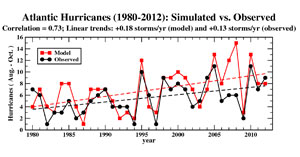
Turning to future climate projections, current climate models suggest that tropical Atlantic SSTs will warm dramatically during the 21st century, and that upper tropospheric temperatures will warm even more than SSTs. Furthermore, most of the CMIP3 models project increasing levels of vertical wind shear over parts of the western tropical Atlantic (see Vecchi and Soden 2007). Both the increased warming of the upper troposphere relative to the surface and the increased vertical wind shear are detrimental factors for hurricane development and intensification, while warmer SSTs favor development and intensification. To explore which effect of these effects might “win out”, we can run experiments with our regional downscaling model.
Our regional model projects that Atlantic hurricane and tropical storms are substantially reduced in number, for the average 21st century climate change projected by current models, but have higher rainfall rates, particularly near the storm center. The average intensity of the storms that do occur increases by a few percent (Figure 6), in general agreement with previous studies using other relatively high resolution models, as well as with hurricane potential intensity theory (Emanuel 1987).
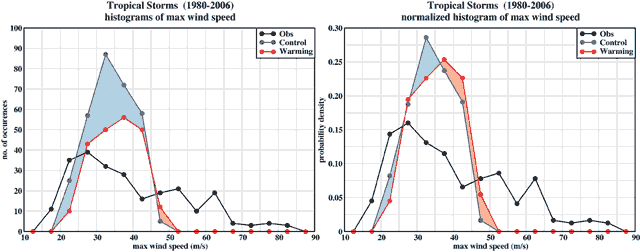
Late 21st century projections of hurricane activity support the notion of increased intensity (~ 4%) and near-storm rainfall rates (~ 10 to 15%) for the Atlantic basin (Knutson et al. 2013) as well as for most other tropical cyclone basins (Knutson et al. 2015). Wright et al. (2015) found model-projected increases in rainfall rates for U.S. landfalling tropical cyclones using this modeling system.
A review of existing climate change projection studies, including the ones cited above, lead us to conclude that: it is likely that greenhouse warming will cause hurricanes in the coming century to be more intense globally and have higher rainfall rates than present-day hurricanes.
Turning now to the question of the frequency of very intense hurricanes, Bender et al. 2010 and Knutson et al. 2013, obtained tropical storm genesis information from an Atlantic basin regional model (Knutson et al. 2008), and then downscaling all of the individual storms from the regional model into the GFDL hurricane prediction system. The GFDL hurricane model (with a grid spacing as fine as 9 km) was able to simulate the frequency, intensity, and structure of the more intense hurricanes, such as category 3-5 storms, much more realistically than the regional (18 km grid) model.
Using this additional downscaling step, the GFDL hurricane model reproduces some important historical characteristics of very intense Atlantic hurricanes, including the wind speed distribution and the change of this distribution between active and inactive decadal periods of hurricane activity (Fig. 1 of Bender et al. 2010). The model also supports the notion of a substantial decrease (~25%) in the overall number of Atlantic hurricanes and tropical storms with projected 21st century climate warming. However, using the CMIP3 and CMIP5 multi-model climate projections, the hurricane model also projects that the lifetime maximum intensity of Atlantic hurricanes will increase by about 5% during the 21st century in general agreement with previous studies.
Downscaled projections using CMIP5 multi-model scenarios (RCP4.5) as input (Knutson et al. 2013) showed increases in category 4 and 5 storm frequency (Fig. 7). However, these increases were only marginally significant for the early 21st century (+45%) or the late 21st century (+39%) CMIP5 scenarios. That study also downscaled ten individual CMIP3 models in addition to the multi-model ensemble, and found that three of ten models produced a significant increase in category 4 and 5 storms, and four of the ten models produced at least a nominal decrease. While multi-model ensemble results are probably more reliable than individual model results, each of the individual model results can be viewed as at least plausible at this time. The projected changes in Knutson et al. (2013) were not as large or significant as those of the earlier study by Bender et al. (2010) but were based on a larger sample of models. Based on Knutson et al. (2013) and a survey of subsequent results by other modeling groups, at present we have only low confidence for an increase in category 4 and 5 storms in the Atlantic, but higher confidence that the fraction of storms that reach category 4 and 5 will increase.
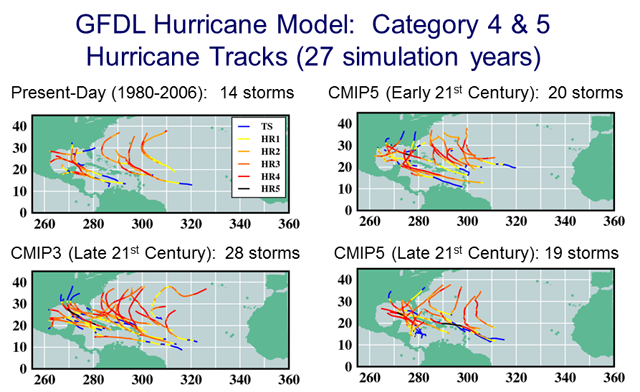
control climate (upper left); CMIP3/A1B 18-model ensemble late 21st century (lower left); and CMIP5/RCP4.5 18-model ensemble early (upper right) or late (lower right) 21st century. All results shown are based on model version GFDL. Track colors indicate the intensity category during the storm’s lifetime. From Knutson et al. (2013).
Returning to the issue of future projections of aggregate activity (PDI, as in Fig. 1), while there remains a lack of consensus among various studies on how Atlantic hurricane PDI will change, no model we have analyzed shows a sensitivity of Atlantic hurricane PDI to greenhouse warming as large as that implied by the observed Atlantic PDI/local SST relationship shown in Figures 1 (top panel). In other words,
there is little evidence from current dynamical models that 21st century climate warming will lead to large (~300%) increases in tropical storm numbers, hurricane numbers, or PDI in the Atlantic.
Concerning the potential detectability of Atlantic hurricane frequency climate change signals, Bender et al (2010) estimate that detection of an anthropogenic influence on intense (Category 4-5) hurricanes would not be expected for a number of decades, even if a large underlying increasing trend (+10% per decade) were occurring.
Changes in the tracks or locations of genesis and occurrence of U.S. landfalling tropical cyclones could also change with climate warming. Two recent studies (Garner et al. 2021; Knutson et al. 2022) project that an increasing fraction of Atlantic tropical cyclones will make U.S. landfall, especially along the U.S. East Coast, in a greenhouse gas-warmed climate. In Knutson et al. (2022) these changes are linked to storm formation shifting closer to the U.S. coast and a weakening of westerly tropospheric steering flow that slightly weakens the recurvature of storm tracks away from the U.S. coast. However, given the diversity of responses across different published studies, as discussed here and in the above papers, no modeling consensus is yet available on Atlantic tropical cyclone geographical shifts in location.
E. Other possible influences on past Atlantic hurricane activity
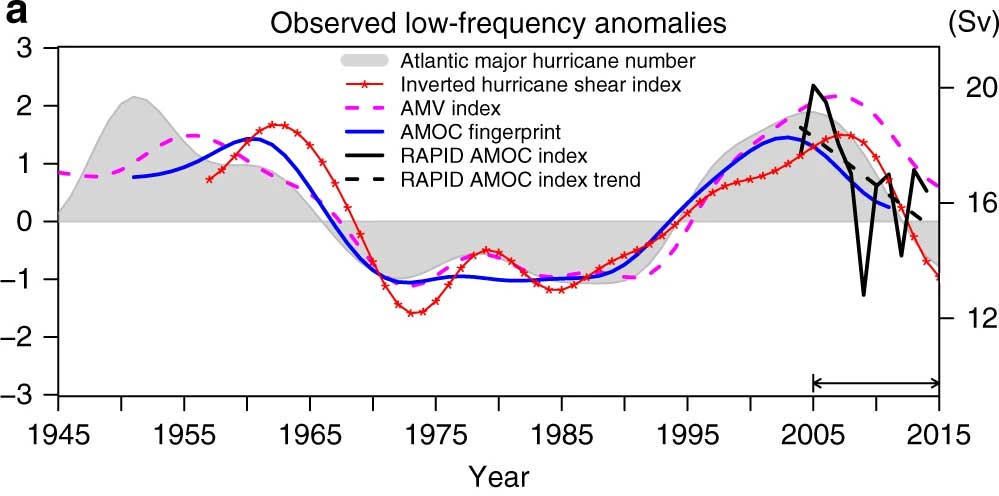
Atlantic basin major hurricanes, while increasing from the 1970s to 2005, have undergone pronounced “ups and downs” or multidecadal variability since the 1950s (Fig. 8, gray shading, from Yan et al. 2017). High major hurricane activity has been correlated with low values of tropical Atlantic vertical wind shear (Fig. 8, red curve). What human or natural influences could have contributed to these multidecadal variations? Mann and Emanuel (2006) hypothesized that a reduction in aerosol-induced cooling over the Atlantic in recent decades may have contributed to an enhanced warming of the tropical North Atlantic since the 1970s. However, the cause or causes of the recent enhanced warming of the Atlantic, relative to other tropical basins, and its effect on Atlantic tropical cyclones, remains highly uncertain (e.g., Booth et al. 2012; Zhang et al. 2013; Dunstone et al. 2013; Villarini and Vecchi 2013; Vecchi et al. 2017; Yan et al. 2019).
A number of anthropogenic and natural factors (e.g., aerosols, greenhouse gases, volcanic activity, solar variability, and internal climate variability) must be considered as potential contributors to the observed variability. As one example, Fig. 8 illustrates how Atlantic major hurricane frequency and tropical Atlantic vertical wind shear have been well-correlated with detrended north Atlantic sea surface temperatures and with an index or “fingerprint” of inferred changes in the Atlantic Ocean meridional overturning circulation (AMOC) over the past six decades. [For a review of the link between the AMOC and Atlantic Multidecadal Variability, see Zhang et al. 2019.] While Fig. 8 suggests some role for internal climate variability involving ocean circulation in Atlantic hurricane variability, the correlation shown in the figure does not establish causation between internal climate variability and Atlantic hurricane variability. However, a causal link between internal AMOC variability and Atlantic Multidecadal Variability has been established in modeling studies; Zhang and Delworth (2006) further demonstrated a causal linkage between Atlantic Multidecadal Variability and multidecadal Atlantic vertical wind shear in hybrid coupled model experiments with the prescribed Atlantic Multidecadal Variability forcing.
The relative contributions of different mechanisms in driving the observed Atlantic Multidecadal Variability and Atlantic hurricane variability remains a topic of active research. IPCC AR5 concluded that there is medium confidence that reduced aerosol forcing contributed to the observed increase in Atlantic tropical cyclone activity since the 1970s, but does not state any estimate of the magnitude of contribution.
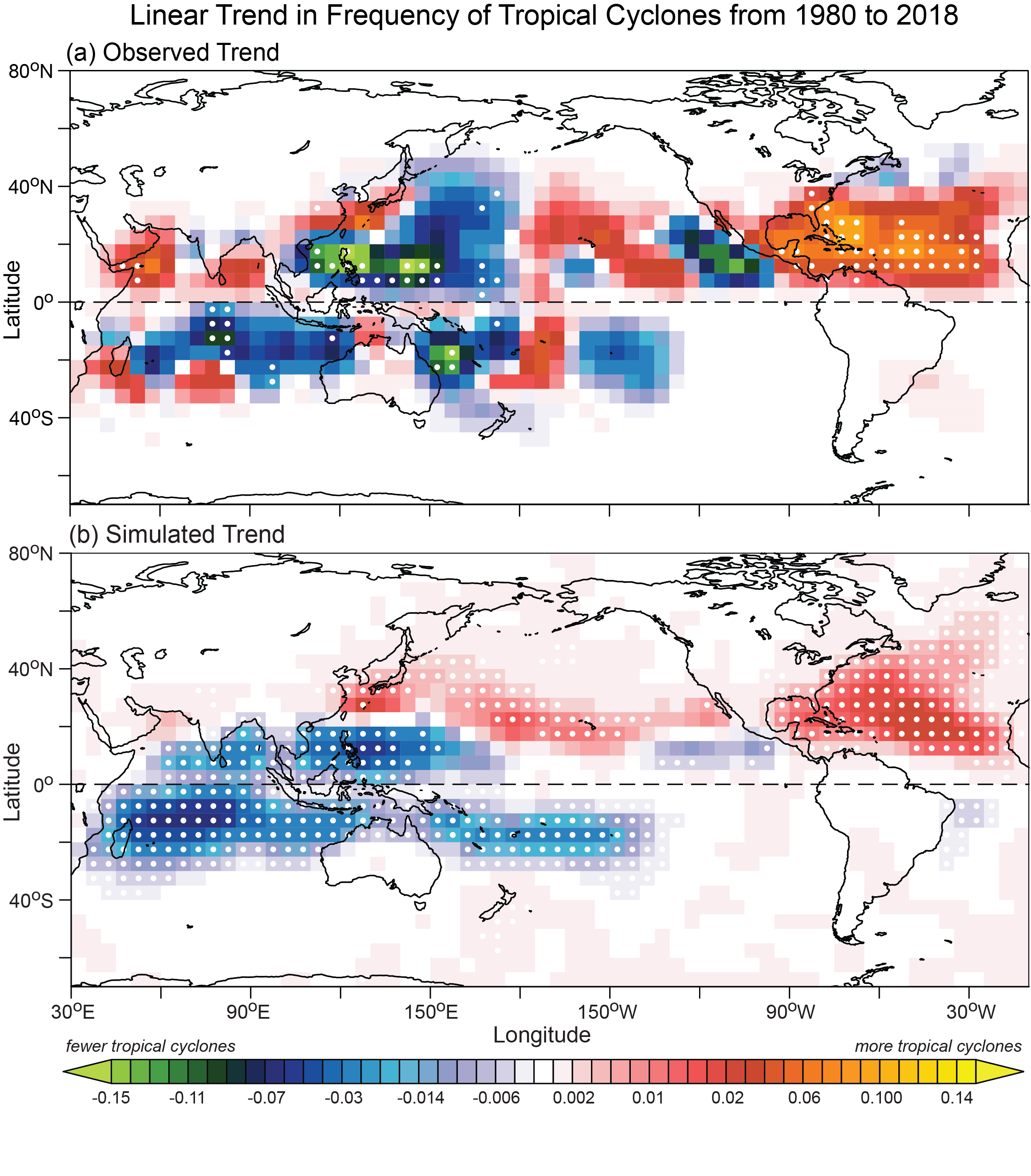
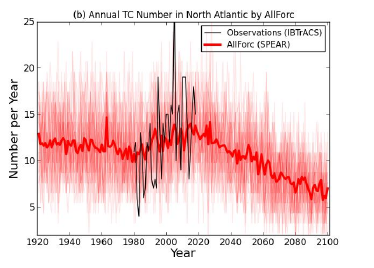
Murakami et al. (2020) used models and fingerprint detection/attribution techniques to explore the causes of the observed global pattern of change in tropical storm frequency since 1980 (Fig. 9, top panel). Their models, forced by anthropogenic and natural forcings (Fig. 9, bottom panel), produce a fairly good representation of the global pattern of the observed trend. For the Atlantic basin (Fig. 10), they conclude that external forcings, and particularly changes in forcing from anthropogenic aerosols, and volcanic eruptions, likely played an important role in the increased tropical storm frequency since 1980. A similar finding for the Atlantic was reported by Dunstone et al. (2013) using a different model. Figure 10 suggests that observed increase in Atlantic tropical cyclones from about 1980-2020 (black curve) resulted in part from the response to external forcings (red curve). The temporary upswing in the red curve (model simulated storms) during this period resulted from effects of anthropogenic aerosols and greenhouse gases. These had tended to suppress Atlantic tropical storm frequency in the model during the 20th century prior to the 1980s, but tropical cyclone frequency increased temporarily from about 1980 to 2020 as this suppression effect was reduced due to decreased aerosol emissions over North America and Europe. Wang et al. (2024) conclude that increased tropical cyclone frequency over 1980-2020 near the U.S. Atlantic coast was likely related to changes in aerosol forcing influence. Rousseau-Rizzi and Emanuel (2022) conclude that aerosols caused changes in precipitation and dust emissions over the Sahara-Sahel region of Africa, which amplified the cooling effect of aerosols over the Atlantic in the 1970s and 80s. Meanwhile, Murakami et al., Dunstone et al. and Wang et al. project, for the Atlantic, a decrease in tropical storm frequency over the coming century, as greenhouse gas influences dominate over projected aerosol influences. Natural climate variability further complicates confident detection of such aerosol-related influences on Atlantic tropical cyclone activity and make predictions for the coming decades very challenging. A better understanding of the relative contributions of natural variability, anthropogenic aerosols, and increasing greenhouse gases to the observed Atlantic Multidecadal Variabilty and the increases in hurricane activity metrics since 1980 is needed. These factors and their relative influence have important implications for what to expect for Atlantic hurricane activity over the next few decades.
Sea level rise must also be considered as a way in which human-caused climate change can impact Atlantic hurricane climate–or at least the impacts of the hurricanes at the coast. The vulnerability of coastal regions to storm-surge flooding is expected to increase with future sea-level rise and coastal development, although this vulnerability will also depend upon future storm characteristics, as discussed above. All else equal, coastal inundation levels associated with tropical cyclones should increase with sea level rise. There are large ranges in the 21st century projections for both Atlantic hurricane characteristics and for the magnitude of regional sea level rise along the U.S. coastlines. However, according to the IPCC AR5, the average rate of global sea level rise over the 21st Century will very likely exceed that observed during 1971-2010 for a range of future emission scenarios.
F. Summary for Atlantic Hurricanes and Global Warming
In summary, neither our model projections for the 21st century nor our analyses of trends in Atlantic hurricane and tropical storm activity support the notion that greenhouse gas-induced warming leads to large increases in either tropical storm or overall hurricane numbers in the Atlantic. A recent study finds that the observed increase in an Atlantic hurricane rapid intensification metric over 1982-2009 is highly unusual compared to one climate model’s simulation of internal multidecadal climate variability, and is consistent in sign with that model’s expected long-term response to anthropogenic forcing. Studies of extreme precipitation events in Texas and tropical cyclone precipitation in Puerto Rico are suggestive of emerging anthropogenic influence on hurricane precipitation. The above climate change detection/attribution studies are not yet definitive for hurricane activity metrics, and more research is needed for more confident conclusions. A slowing of tropical cyclone propagation speeds over the continental U.S. has been found since 1900, but its cause remains uncertain.
Therefore, it is premature to conclude with high confidence that human-caused increases in greenhouse gases have caused a change in past Atlantic basin hurricane activity that is outside the range of natural variability, although greenhouse gases are strongly linked to global warming. Some possible emerging human influences on past tropical cyclone activity were summarized above. These include, for the Atlantic, recent increases in rapid intensification probability and increases in extreme tropical cyclone precipitation in some regions. Studies suggest that the increase in tropical storm frequency in the Atlantic basin since the 1970s has been at least partly driven by decreases in aerosols from human activity and volcanic forcing, but other processes, such as natural variability, likely also played a role. A number of measures of Atlantic hurricane activity have increased since 1980 (e.g., rapid intensification, intensities, number of major hurricanes, number of hurricanes), but in cases of metrics where much longer records are available (e.g., U.S. landfalling major hurricanes or hurricanes, adjusted basin-wide counts of major hurricanes or hurricanes), there is not clear evidence for detectable increases, implying that trends since 1980 should not be assumed to be representative of longer (e.g., century-scale) trends. Substantial multidecadal variability in the basin confounds efforts to detect long-term (century-scale) trends of the type that might be anticipated as responses to increasing greenhouse gases. Human activities may have already caused other changes in tropical cyclone activity that are not yet clearly apparent due to the small magnitude of these changes compared to estimated natural variability, or due to observational limitations.
Concerning future changes, a number of climate modeling studies project that climate warming will cause Atlantic hurricanes in the coming century to have higher rainfall rates than present-day hurricanes, and that they will be more intense (higher peak winds and lower central pressures) on average. All else equal, coastal inundation levels associated with tropical cyclones should increase with sea level rise as projected for example by IPCC AR5. Published studies also suggest that greenhouse gas warming will lead to future decreases in Atlantic tropical storm frequency and possibly to increases in very intense hurricane frequency, although there is uncertainty in these projections and a range or results across different modeling studies. Recent studies point to a possible future increase in the fraction of hurricanes that make U.S. landfall, but again there is no consensus across studies on this projection. These assessment statements are intended to apply to a global warming scenario of roughly 2 degrees Celsius.
The relatively conservative confidence levels attached to our Atlantic hurricane projections, and the lack of a claim of detectable anthropogenic influence on Atlantic hurricane activity at this time contrasts with the situation for other climate metrics, such as global mean temperature. The IPCC AR6 concludes that it is unequivocal that humans have caused the earth’s climate to warm, with a likely human contribution of 0.8 to 1.3 degrees Celsius to global mean temperature since the late 1800s.
3. Global Tropical Cyclone Activity and Climate Warming
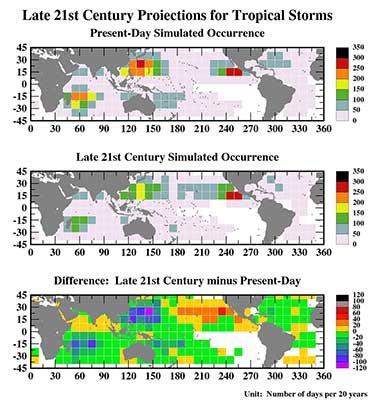
The main focus of this web page is on Atlantic hurricane activity and global warming. However, an important question concerns whether global warming has or will substantially affect tropical cyclone activity in other basins.
In terms of historical tropical cyclone activity, recent work (Kossin et al. 2014; see GFDL Research Highlight; Kossin et al. 2016) indicates that the latitude at which the maximum intensity of tropical cyclones occurs has expanded poleward globally in recent decades. The poleward shift in the Northwest Pacific they conclude is unusual compared to expected variability from natural causes but consistent with general expectations of such a shift due to anthropogenic warming seen in climate model experiments. The poleward shift has been found in both hemispheres, but is not seen in the Atlantic basin. The observed change in the Northwest Pacific basin is assessed to be detectable (i.e., not explainable by internal variability alone) with medium confidence (IPCC AR6) and low-to-medium confidence (WMO Task Team report).
Kossin et al. (2020) document an increase in the global fraction of 6-hourly tropical cyclone intensity “fixes” of at least Category 3 intensity over the period 1979-2017. These observed changes, while statistically significant according to linear trend significance tests, have not been compared with modeled changes in the fraction of storm 6-hourly intensity values reaching Category 3 in response to historical anthropogenic forcing, nor have they been compared to model-simulated natural variability in this metric. This change is assessed to be detectable (i.e., not explainable by natural variability alone) with medium confidence (IPCC AR6). The increase in proportion of Category 3-5 six-hourly intensity “fixes” was reported by Jewson and Lewis (2020) to be mostly due to a global decrease in the number of Category 1-5 intensity “fixes”, together with a slight (non-significant) global increase in the number of Category 3-5 intensity “fixes”. A global increase in the intensities of weak tropical cyclones of 1.8 m/sec per decade was inferred by Wang et al. (2022), based on ocean current measurements over the period 1991-2020, supporting other satellite-based TC intensity studies, though over a shorter (three decade) time period. The Bhatia et al. 2019 study finds evidence, as discussed in section 2C above, for detectable increases since 1982 in rapid intensification cases as a fraction of all cases–for the Atlantic, globally, and especially for the NW Pacific basin. Experiments with a single model suggest that the observed change is highly unusual compared to model simulated internal variability and in the same (positive) direction as simulated for idealized historical forcing change over much of the tropics in that model. Limitations of their study include the dependence on a single model, limited length of the available record (since 1982), and very idealized simulation of anthropogenic historical influence to date on rapid intensification. Balaguru et al. (2024) find that TC intensification rates have increased in near-coastal regions around the globe during 1979-2020, related to decreased vertical windshear and increased environmental relative humidity in those regions. They did not formally attributed the observed increases to human-caused climate change, with historical increases much weaker than observed simulated by climate model historical runs.
Murakami et al. (2020) used models and fingerprint detection/attribution techniques to explore the causes of the observed spatial pattern of tropical storm frequency trends (regional increases and decreases) around the globe over 1980-2018 (Fig. 9). The pattern of change in tropical storm frequency they simulate since 1980 is similar to that observed, suggesting a detectable influence from external forcings (anthropogenic greenhouse gases, aerosols, and volcanic activity). Wang et al. (2024) conclude that the observed increase in TC frequency near Hawaii over 1980-2020 was likely related to greenhouse gas-induced climate change. An earlier study (Murakami et al. 2015) had found little evidence for a pronounced increase in TC frequency near Hawaii over the longer period 1949-2014 although they also concluded that anthropogenic forcing was acting to increase TC occurrence there.
As in the Atlantic basin, global tropical cyclone frequency timeseries do not show evidence for significant rising trends. For example, globally aggregated tropical cyclone frequency (tropical storms plus hurricanes, or hurricane-strength storms) and global landfalling tropical cyclone frequency for either Category 1-2 or Category 3-5 tropical cyclones (1970 to ~2017) do not show significant trends (Knutson et al. 2019). Further, century-scale timeseries of landfalling tropical cyclones in Japan show no significant trend, while severe landfalling tropical cyclones in eastern Australia have a significant downward trend, whose cause remains undetermined (Knutson et al. 2019). Updated timeseries for several global tropical cyclone metrics (basinwide and landfalling storms) are presented here.
Despite the difficulty in identifying a detectable influence of human-caused greenhouse gas increases on global tropical cyclone activity, greenhouse gas-induced climate change may have already caused changes in tropical cyclone activity that are not yet detectable due to their small magnitude compared to estimated natural variability, or due to observational limitations.
For future projections, GFDL atmospheric modelers have developed global models capable of simulating many aspects of the seasonal and year-to-year variability of tropical cyclone frequency in a number of basins, using only historical sea surface temperatures as input. Examples of the performance of these models on historical data are provided on this web page.
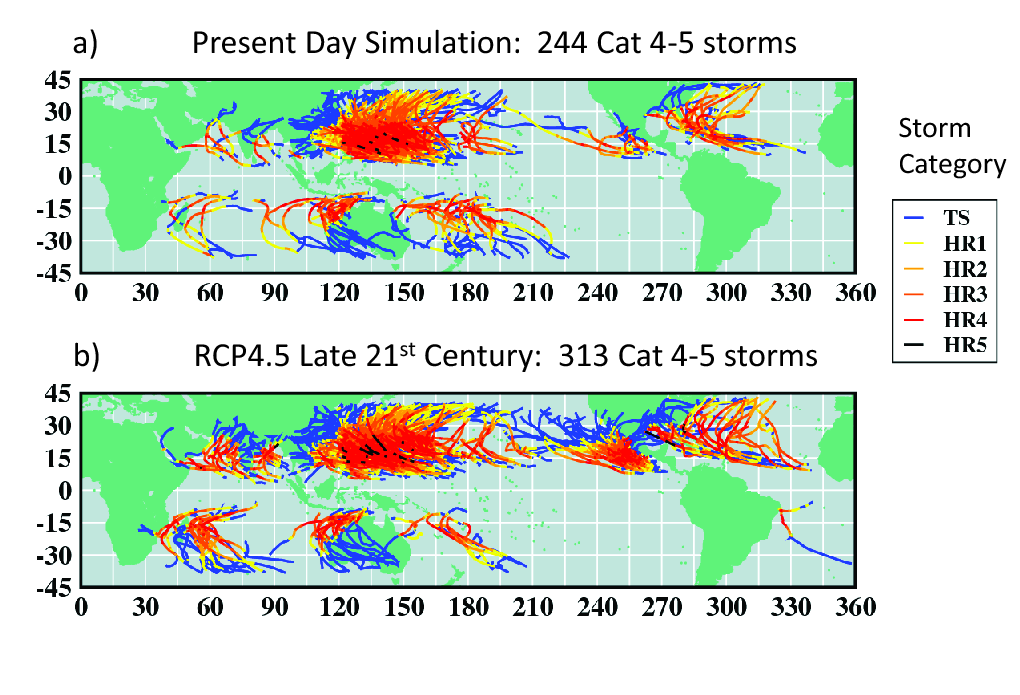 Figure 12 (click to enlarge) Simulated present day (top), and projected late 21st century (bottom) Category 4-5 tropical cyclone tracks. Colors indicate storm Category (legend). From Knutson et al. (2015).
Figure 12 (click to enlarge) Simulated present day (top), and projected late 21st century (bottom) Category 4-5 tropical cyclone tracks. Colors indicate storm Category (legend). From Knutson et al. (2015).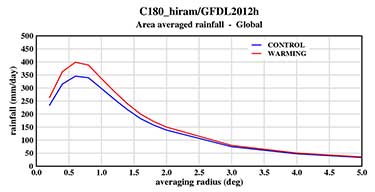 Figure 13 (click to enlarge). Simulated present day (blue), and projected late 21st century (red) composite tropical cyclone rain rates (mm/day) as function of distance from the storm center in degrees latitude. From Knutson et al. (2015).
Figure 13 (click to enlarge). Simulated present day (blue), and projected late 21st century (red) composite tropical cyclone rain rates (mm/day) as function of distance from the storm center in degrees latitude. From Knutson et al. (2015).Knutson et al. (2015) examines the impact of 21st-century projected climate changes (CMIP5, RCP4.5 scenario) on a number of tropical cyclone metrics, using the GFDL hurricane model to downscale storms in all basins from one of the lower resolution global atmospheric models mentioned above. Key findings from these experiments include: fewer tropical cyclones globally in a warmer late-twenty-first-century climate (Figure 11), but also an increase in average cyclone intensity, the number and occurrence days of very intense category 4 and 5 storms in most basins (Figure 12) and in tropical cyclone precipitation rates (Figure 13).
Based on current published results, we conclude that at the global scale: a future increase in tropical cyclone precipitation rates is likely; an increase in tropical cyclone intensity is likely; an increase in very intense (category 4 and 5) tropical cyclones is more likely than not; and there is medium confidence in a decrease in the frequency of weaker tropical cyclones. Existing studies suggest a tropical cyclone windspeed increase of about 1-10% and a tropical cyclone precipitation rate increase of about 14% (+6 to +22%) for a 2 degree Celsius global warming scenario. While the median model projection of 14% is close to the rate at which water vapor increases in the atmospheric with climate warming (7% per degree Celsius SST warming), some model projections exceed this rate. Liu et al. (2019) find that this “super-Clausius-Clapeyron” rate of tropical cyclone precipitation increase is due to the additional effect on precipitation of a strengthening of the storm’s circulation intensity in their model. The above global projections are similar to the consensus findings from a review of earlier studies in the 2010 WMO assessment. [According to climate change assessments, there is medium confidence for a detectable human contribution to past observed increases in heavy precipitation in general over global land regions and for the United States, although this increase has not been formally detected for hurricane precipitation alone.]
These global-scale changes are not necessarily projected to occur in all tropical cyclone basins. For example, Knutson et al. (2015) projects an increase in tropical storm frequency in the Northeast Pacific and near Hawaii, and a decrease in category 4-5 storm days over much of the southern hemisphere basins and parts of the northwest Pacific basin–both at variance with the global-scale projected changes. These differences in responses between basins seem to be linked to how much SSTs increase in a given region compared to the tropical mean increase in SST. Basins that warm more than the tropical average tend to show larger increases in tropical cyclone activity for a number of metrics.
A modeling study (Zhang et al. 2020) of tropical cyclone propagation speed finds that future anthropogenic warming could lead to a significant slowing of hurricane motion, including in the Atlantic off the east coast of the U.S. in mid-latitudes. However, the study concluded that the observed global slowdown of tropical cyclone motion could not be easily linked to anthropogenic climate change.
Knutson et al. (2015) simulations also project little change in the median size of tropical cyclones globally; the model shows some skill at simulating the differences in average storm size between various basins in the present-day climate, lending some credibility to its future climate change projections of tropical cyclone size.
The tropical cyclone global warming projection studies discussed above have emphasized dynamical modeling studies done at GFDL/NOAA in recent years. A 2020 WMO-initiated assessment report on projections of tropical cyclones and climate change reviews a number of published studies by different research groups. The report summarized projections for all tropical cyclone frequency, category 4-5 tropical cyclone frequency, tropical cyclone intensity, and tropical cyclone precipitation rates for each basin and globally (Fig. 14) for a 2 degree Celsius global warming scenario. The results in Fig. 14 indicate that the greatest agreement across modeling studies is for an increase in rain rates and intensity, whereas frequency change (whether for all tropical cyclones or for category 4-5 tropical cyclones) does not show as much agreement across studies. The global proportion of tropical cyclones that reach very intense (category 4 and 5) levels is projected to increase (medium to high confidence) due to anthropogenic warming, according to the assessment (not shown).
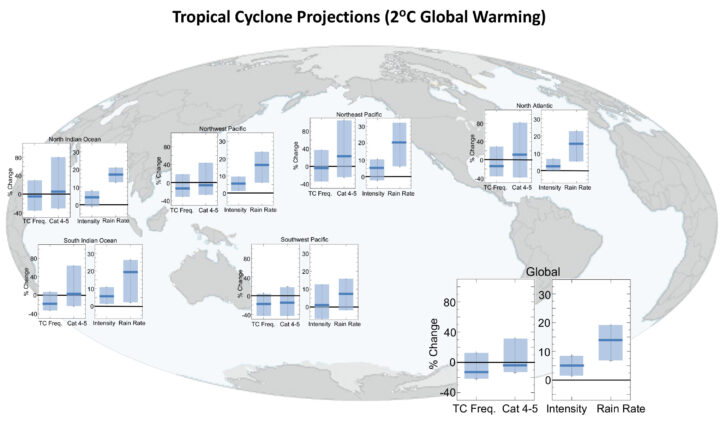
More recently, the Balaguru et al. (2024) study of past and future increased near-coastal TC intensification rates projects an increase in the future due to greenhouse gas-dominated global warming. However, they note that the future increases depend on changes in atmospheric heating patterns and sea surface temperature (SST) patterns, with an El Nino-like future warming being an important driver. While climate models generally produce an El Nino-like warming in long-term (21st century) projections, a number of studies (e.g., Zhao and Knutson 2023) show that climate models also fail to simulate the La Nina-like SST trend pattern observed over 1979-2020, including the slight cooling of the eastern equatorial Pacific and Southern Ocean. Further, as shown by Zhao and Knutson (2024) and Sobel et al. (2023) the pattern of future SST warming is very important for future regional projections of TC activity. This implies that the model-observations discrepancies in SST trend patterns, whether due to natural variability or model errors in response to various climate forcings, is an area where further research is urgently needed to increase confidence in future regional TC projections.
4. Recent Relevant GFDL Papers and Animations
- Crucial role of sea surface temperature warming patterns in near-term high-impact weather and climate projection. Ming Zhao and T. Knutson, npj Climate and Atmospheric Science (2024)
- Dynamical downscaling projections of late twenty-first-century U.S. landfalling hurricane activity. (Knutson, T.R., Sirutis, J.J., Bender, M.A. , Tuleya, R. E., and Schenkel, B.), 2022. Climatic Change 171, 28. https://doi.org/10.1007/s10584-022-03346-7
- Detected climatic change in global distribution of tropical cyclones. (H. Murakami, T. L. Delworth, W. F. Cooke, M. Zhao, B. Xiang, and P-C Hsu), 2020: Proceedings of the National Academy of Sciences, 117(20), DOI:10.1073/pnas.1922500117.
- Tropical cyclone motion in a changing climate. (G. Zhang, H. Murakami, T. R. Knutson, R., and K. Yoshida), 2020: Science Advances, 6(17), eaaz7610, DOI:10.1126/sciadv.aaz7610.
- Recent increases in tropical cyclone intensification rates. (K. Bhatia, G. A. Vecchi, T. R. Knutson, H. Murakami, J. Kossin, K. W. Dixon, and C. E. Whitlock), 2019: Nature Communications, 10, 635, DOI:10.1038/s41467-019-08471-z.
- The role of Atlantic overturning circulation in the recent decline of Atlantic major hurricane frequency.(Yan, Zhang, and Knutson) Nature Communications, 2017, 8, 1695, DOI:
10.1038/s41467-017-01377-8 - Dominant Role of Atlantic Multi-decadal Oscillation in the Recent Decadal Changes in Western North Pacific Tropical Cyclone Activity. (Zhang, W., G. A. Vecchi, H. Murakami, G Villarini, T. L Delworth, X. Yang, and L. Jia), 2018: Geophysical Research Letters, 45(1), DOI:
10.1002/2017GL076397 . - Increasing frequency of extremely severe cyclonic storms over the Arabian Sea (Murakami, Vecchi, and Underwood) Nature Climate Change, 2017, 7(12), DOI: 10.1038/s41558-017-0008-6 .
- Future changes in tropical cyclone activity in high-resolution large-ensemble simulations. (Yoshida, K, M Sugi, R Mizuta, Hiroyuki Murakami, and M Ishii,) 2017: Geophysical Research Letters, 44(19), DOI: 10.1002/2017GL075058 .
- Western North Pacific tropical cyclone model tracks in present and future climates. (Nakamura, J, S J Camargo, A Sobel, N Henderson, K A Emanuel, A Kumar, T LaRow, Hiroyuki Murakami, M Roberts, E Scoccimarro, P L Vidale, H Wang, M F Wehner, and Ming Zhao), 2017: Journal of Geophysical Research, 122(18), DOI: 10.1002/2017JD027007 .
- Projection of future changes in the frequency of intense tropical cyclones. (Sugi, M, Hiroyuki Murakami, and K Yoshida), 2017: Climate Dynamics, 49(1-2), DOI: 10.1007/s00382-016-3361-7 .
- Global Projections of Intense Tropical Cyclone Activity for the Late Twenty-First Century from Dynamical Downscaling of CMIP5/RCP4.5 Scenarios (Knutson, et al.), J. Climate, Sept. 2015.
- Investigating the Influence of Anthropogenic Forcing and Natural Variability on the 2014 Hawaiian Hurricane Season. (Murakami, H., et al.), 2015: Bulletin of the American Meteorological Society, 96(12), DOI: 10.1175/BAMS-EEE_2014_ch23.1 .
- Influences of Natural Variability and Anthropogenic Forcing on the Extreme 2015 Accumulated Cyclone Energy in the Western North Pacific [in “Explaining Extremes of 2015 from a Climate Perspective”], (Zhang, W. et al.) 2016: Bulletin of the American Meteorological Society, 97(12), DOI: 10.1175/BAMS-D-16-0146.1 S131-S135.
- Simulation and Prediction of Category 4 and 5 Hurricanes in the High-Resolution GFDL HiFLOR Coupled Climate Model. (Murakami, H., et al.) 2015: Journal of Climate, 28(23), DOI: 10.1175/JCLI-D-15-0216.1.
- Regional climate model projections of rainfall from U.S. landfalling tropical cyclones. (Wright, Knutson, and Smith), Climate Dynamics, 2015.
- More tropical cyclones in a cooler climate? (Sugi, M., K. Yoshida, and Hiroyuki Murakami, 2015, Geophysical Research Letters, 42(16), DOI: 10.1002/2015GL064929 .)
- The poleward migration of the location of tropical cyclone maximum intensity, (Kossin, Emanuel, and Vecchi; Nature 2014). (see GFDL Research Highlight)
- Dynamical Downscaling Projections of Twenty-First-Century Atlantic Hurricane Activity: CMIP3 and CMIP5 Model-Based Scenarios, J. Climate 2013.
- TC-permitting GCM simulations of hurricane frequency response to sea surface temperature anomalies projected for the late 21st century. J. Climate 2012.
- Modeled Impact of Anthropogenic Warming on the Frequency of Intense Atlantic Hurricanes. Science 2010
- FAQ (Frequently Asked Questions) on our recent Science paper (updated Jan. 25, 2010)
- How well do we know past Atlantic hurricane activity? A web site on adjusting for “missing storms” in the past Atlantic hurricane data.
- Simulations of global hurricane climatology, interannual variability, and response to global warming using a 50km resolution GCM. J. Climate, 2009.
- Simulated reduction in Atlantic hurricane frequency under twenty-first-century warming conditions, Nature Geoscience, doi:10.1038/ngeo202(Published online May 2008)
- FAQ (Frequency Asked Questions) on our recent Nature Geoscience study (Posted June 11, 2008)
- On Estimates of Historical North Atlantic Tropical Cyclone Activity — J. Climate (July 15, 2008 issue)
- Simulation of the recent multidecadal increase of Atlantic hurricane activity — BAMS (October 2007 issue)
- Simulated Hurricane Animations Web Page
5. Assessment of Tropical Cyclones and Climate Change
A new ScienceBrief Review on Tropical Cyclones and Climate Change has been published (Mar. 26, 2021).
An updated WMO Task Team assessment on tropical cyclones and climate change was published (2019; 2020) in the Bulletin of the American Meteorological Society:
I) “Tropical Cyclones and Climate Change Assessment. Part I: Detection and Attribution”
The WMO Task Team assessment above updates the March 2010 assessment “Tropical Cyclones and Climate Change”, produced by the preceding WMO Expert Team.
These reports assess published research on tropical cyclones and climate change from the international scientific literature.
6. Early GFDL Research on Global Warming and Hurricanes
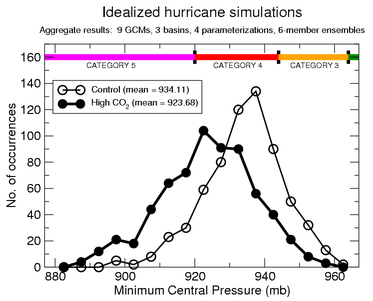
The strongest hurricanes in the present climate may be upstaged by even more intense hurricanes over the next century as the earth’s climate is warmed by increasing levels of greenhouse gases in the atmosphere. Although we cannot say at present whether more or fewer hurricanes will occur in the future with global warming, the hurricanes that do occur near the end of the 21st century are expected to be stronger and have significantly more intense rainfall than under present day climate conditions. This expectation (Figure 15) is based on an anticipated enhancement of energy available to the storms due to higher tropical sea surface temperatures.
The results shown in Figure 15 are based on a simulation study carried out by Thomas R. Knutson and Robert E. Tuleya at NOAA’s Geophysical Fluid Dynamics Laboratory (GFDL). In this study hurricanes were simulated for a climate warming as projected to occur with a substantial build-up of atmospheric CO2. An increase of intensity of about one-half category on the Saffir-Simpson scale was simulated for an 80 year build-up of atmospheric CO2 at 1%/yr (compounded). For hurricane wind speeds, our model shows a sensitivity of about 4% per degree Celsius increase in tropical sea surface temperatures, with a larger percentage increase in near-storm rainfall.
Early Studies on Global Warming and Hurricanes
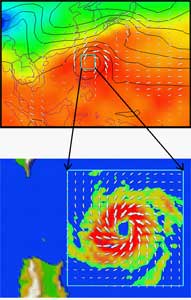
An increase in the upper-limit intensity of hurricanes with global warming was suggested on theoretical grounds by M.I.T. Professor Kerry Emanuel in 1987. In the late 1990s, Knutson, Tuleya, and Kurihara at GFDL/NOAA began simulating samples of hurricanes from both the present-day climate and from a greenhouse-gas warmed climate. This was done by “telescoping-in” on coarsely resolved tropical storms in GFDL’s global climate model using the high-resolution GFDL hurricane prediction model (Figure 16). A research report describing this work was published in Science (1998), with a more detailed paper in Climate Dynamics (1999, vol. 15). All of these studies, as well as our more recent ones, include the moderating effect of atmospheric stabilization aloft under high CO2 conditions, rather than simply increasing the sea surface temperature alone.
In a follow-up study, which appeared in the Journal of Climate(2001), NOAA scientists Knutson and Tuleya teamed up with Isaac Ginis and Weixing Shen of the University of Rhode Island to explore the climate warming/ hurricane intensity issue using hurricane model coupled to a full ocean model. The coupled model was used to simulate the “cool SST wake” generated by the hurricanes as they moved over the simulated ocean (Figure 17). The model simulations including this additional feedback still showed a similar percentage increase of hurricane intensity under warm climate conditions as the original model without ocean coupling.
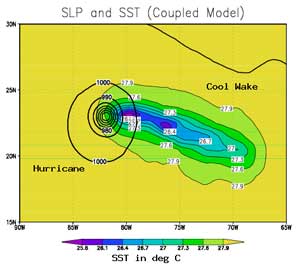
A comprehensive idealized hurricane intensity modeling study by Knutson and Tuleya, published in Journal of Climate (2004), confirms the general conclusions of previous studies but makes them more robust by using future climate projections from nine different global climate models and four different versions of the GFDL hurricane model. The GFDL hurricane model used for the study is an enhanced resolution version of the model used to predict hurricanes operationally at NOAA’s National Centers for Environmental Prediction. According to this latest study, an 80 year build-up of atmospheric CO2 at 1%/yr (compounded) leads to roughly a one-half category increase in potential hurricane intensity on the Saffir-Simpson scale and an 18% increase in precipitation near the hurricane core. A 1%/yr CO2 increase is an idealized scenario of future climate forcing. As noted by the Intergovernmental Panel on Climate Change (IPCC), there is considerable uncertainty in projections of future radiative forcing of earth’s climate. A criticism of our paper by Michaels et al. is responded to here.
An implication of the GFDL studies is that if the frequency of tropical cyclones remains the same over the coming century, a greenhouse-gas induced warming may lead to an increasing risk globally in the occurrence of highly destructive category-5 storms.
Related Links:
For more information and related research see:
- Future projections of global tropical cyclone activity (J. Climate 2015).
- Future projections of intense Atlantic hurricanes (J. Climate 2013).
- Global models of hurricane frequency developed at GFDL.
- Historical changes in Atlantic hurricanes and tropical storms.
- GFDL’s Hurricane Portal
- GFDL Hurricane simulations– animations
- Hurricanes: Science and Society web page
- NOAA State of the Science Fact Sheet on “Atlantic Hurricanes and Climate” (May 2020)


